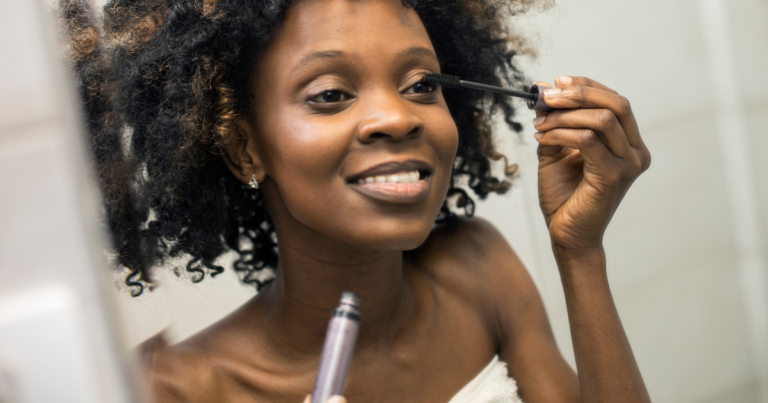Formaldehyde
Formaldehyde is widely used in many consumer products, including building materials, pressed wood, cosmetics, shoe-care products, and textiles. It is also used as a disinfectant and as a preservative, including in mortuaries and medical labs. It has been identified as a cause of leukemia and nose and throat cancer, and linked to asthma and skin irritations.1
There is also a group of chemicals known as formaldehyde releasers, which get added to products like cosmetics to preserve the product by releasing formaldehyde.2
How am I exposed to formaldehyde?
Because formaldehyde is a volatile organic compound (VOC), products that contain the chemical emit it into the air. Products made with formaldehyde will emit this chemical as a vapor for a long time. As a result, most exposure comes from the air, particularly indoor air contaminated by furniture and building materials, cigarettes, and gas stoves. In fact, these sources can lead to indoor formaldehyde concentrations far exceeding outdoor levels, though people living near chemical plants may have higher exposure from outdoor air. People can absorb formaldehyde through breathing, eating, and through their skin.
Homes, schools, and workplaces have multiples sources of formaldehyde3:
- Home furnishings made of composite wood or pressed wood, like couches, cabinets, cribs, and counter tops are likely sources of formaldehyde.
- Building materials, including plywood, paints, and adhesives can contain formaldehyde.
- Wrinkle-resistant or wrinkle-free clothing and home textiles such as curtains may be treated with formaldehyde
- Cigarettes, e-cigarettes, and gas stoves emit formaldehyde.
- Formaldehyde can be found in personal care products such as lotions, shower gel, baby wash, and shampoo, as well as cosmetics and nail polish. Some salon products, such as hair smoothing treatments, have high concentrations.
- Some products, including cleaners, personal care products, and cosmetics, contain chemicals that act as preservatives by releasing formaldehyde into the product.
Some workplaces also have high levels of formaldehyde; furniture makers, morticians, and laboratory workers may have particularly high exposures.4
Why should I be concerned?
The International Agency for Research on Cancer and the State of California have both made determinations that formaldehyde is a known human carcinogen.5,6
- Formaldehyde has been identified as a cause of leukemia and a rare type of throat cancer and linked to leukemia.
- It also irritates the eyes, nose, and throat, and can cause contact dermatitis.
- Formaldehyde exposure can worsen breathing for people with asthma or chronic obstructive pulmonary disorder (COPD).
- Formaldehyde and formaldehyde releasers can be found in hair products and hair straighteners, and women who regularly use hair straighteners have an increased risk of developing uterine cancer and breast cancer.7,8
How can I reduce my exposure?
- We can reduce exposures for everyone by winning policies and market actions to replace formaldehyde with safer substitutes. You can let your favorite retailers, brands, as well as policymakers know that you want them to ban formaldehyde and preservatives that release formaldehyde and make sure substitutes are safer.
- Choose solid wood furniture, and avoid manufactured wood products when possible. If you use manufactured wood products, make sure they are formaldehyde-free. Healthy Building Network has a list of brands made without formaldehyde.
- Look for textiles labeled with the GOTS label, which limits the amount of formaldehyde.
- To avoid personal care products with formaldehyde-releasing preservatives, steer clear of products with DMDM Hydantoin, Quaternium 15, or Bronopol, paraformaldehyde, methanol, 5-brom-5-nitro-1,3-dioxane, diazolidinyl urea, imidazolidinyl urea, sodium hydroxymethyl glycinate, methenamine on the ingredients label.2
- Stay away from clothing labeled pre-shrunk or wrinkle-free. Choose baby products from companies that offer GOTS-certified clothing, such as Monica + Andy, Pact, and Little Lentil Clothing.
- Make sure your home is well ventilated by keeping windows and doors open as much as possible.
What’s the solution?
It is impossible for us to shop our way out of this problem. And we shouldn’t have to. When you walk into a store, you should be able to trust that the products on store shelves are safe.
Companies shouldn’t sell products with dangerous chemicals—especially as scientists continue to learn more about the “silent epidemic” caused by the cumulative impact of all the toxic chemicals we are regularly exposed to. And our state and federal governments shouldn’t allow chemicals on the market until they’re proven safe.
The only way to protect everyone from toxic chemicals like PFAS is to change policies at government and corporate levels to make sure that safer solutions are the norm.
We’re fighting every day to protect you and your loved ones from toxic chemicals like this. To join our fight, please consider making a donation, taking action with us, or signing up for our email list.
Healthy Choices
Key Projects
Take Action

-
- Agency for Toxic Substances & Disease Registry Toxicological Profile for Formaldehyde; 1999.
- European Chemicals Agency Investigation Report: Formaldehyde and Formaldehyde Releasers; Helsinki, Finland, 2017.
- ATSDR Formaldehyde in Your Home: What you need to know. https://www.atsdr.cdc.gov/formaldehyde/home/index.html (June 22),
- National Toxicology Program Formaldehyde Report on Carcinogen Status. https://www.niehs.nih.gov/health/materials/formaldehyde_508.pdf (June 22).
- International Agency for Research on Cancer Monograph on the Evaluation of Carcinogenic Risks to Humans Volume 88; 2006.
- Office of Environmental and Health Hazard Assessment Current Proposition 65 List. http://oehha.ca.gov/proposition-65/proposition-65-list (June 22).
- Use of straighteners and other hair products and incident uterine cancer. JNCI: Journal of the National Cancer Institute. https://doi.org/10.1093/jnci/djac165 (October 2022).
- Hair dye and chemical straightener use and breast cancer risk in a large US population of black and white women. Wiley Online Library. https://doi.org/10.1002/ijc.32738 (December 2019).


